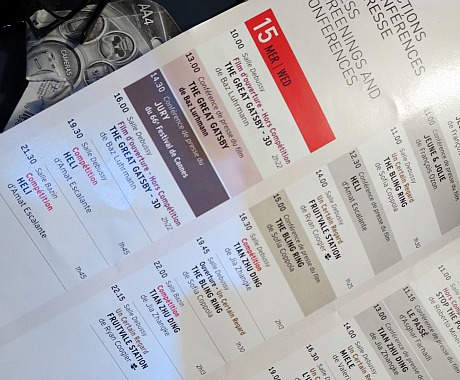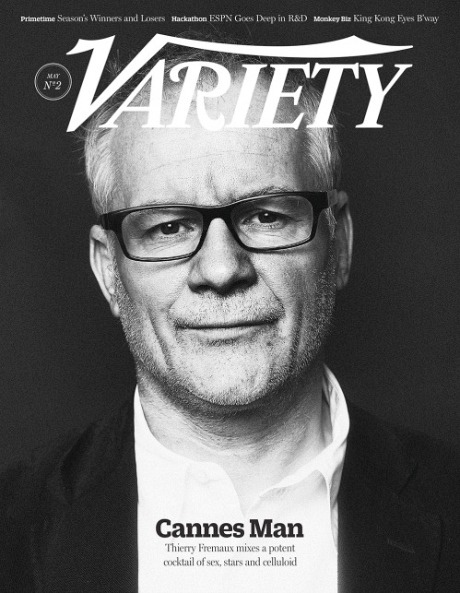Hollywood Reporter critic Todd McCarthy is hearing that J.C. Chandor‘s All Is Lost, an old-man-and-the-sea survivalist drama starring Robert Redford, is a “non-CG Life of Pi.” And dialogue-free, according to a Redford quote that apppeared last January. As long there’s no Bengal tiger involved I’m okay with that. But Redford is in his mid 70s, right? Born in ’36. Okay, next year he’ll be in his late 70s.
Among Last People on Planet To See Great Gatsby
It’s highly doubtful I’ll be sharing any original impressions of The Great Gatsby after catching it this morning at 10 am, or 100 minutes from now. The Gatsby conversation is over and done with. I just have to see it now and get it over with. (Thanks again, Warner Bros. publicity, for not letting me catch that 10.2 screening in NYC.) I’ll be seeing it with the four or five other American stragglers who haven’t yet had the pleasure plus all the European critics and journalists.

Impressionistic Pillow
After last night’s La Pizza gathering I walked around for an hour or so. Even with workmen painting crosswalks and drilling down street barriers and all the other last-minute stuff, Cannes can be quite peaceful and serene, even, before the festival begins. Obviously good for the soul, reminding the traveller that life is about more than just the rumble and the hubbub. Speaking of which I’d better hurry up — The Great Gatsby screening begins in two hours.

Tuesday, 5.14, 10:35 pm.
I walked by the marina last night and took shots of the super-yachts, which are vulgar as the day is long. For every beautiful wooden sailing ship, there are 15 fat-assed, elephant-penis yachts that are all about conveying how rich their owners are and how fearful (or disdainful?) they are of the sea and the natural order of things. I walked by a dark-blue yacht that looked an awful lot like Spielberg’s, moored in a closed-off security area and protected by goons. I guess the yacht was waiting for him to return from dinner, and then it would take him out to the middle of the bay. Talk about serenity — that’s about as tranquil and soul-soothing as it gets.
Flying Seals in Wee Hours
There’s something oddly affecting about being up at 4:30 am at my 19th Century rental not far from the Cannes marina (7 rue Jean Joseph Mero) and hearing the seagulls cawing and meowing and almost barking like seals overhead. The light is somewhere between dark blue and shrouded gray and the city has yet to stir, but the gulls, man….”Eerrrraaaaww! Earhahw! Earhahw…muck, muck, muck, muck!” Gulls have sounded like this for thousands of years, but there’s something about being here and really listening to them in the pre-dawn quiet…it’s a moment.
“No Such Thing As The Place That You Came From”
The new trailer for Ari Folman‘s The Congress, which will screen within hours under Un Certain Regard in Cannes. Now this — this! — is the kind of animation I can roll with. Animation built upon a narrative that clearly says “digital animation is an artificial bullshit reality, visually mesmerizing but sterile” and makes no bones about it.
Brave Lady
“Life comes with many challenges. The ones that should not scare us are the ones we can take on and take control of.” And so ends Angelina Jolie‘s 5.14 N.Y. Times Op-Ed piece, “My Medical Choice,” in which she reveals she underwent a double mastectomy operation last February. The motive was to guard against a high likelihood that she would one day succumb to breast cancer due to a “faulty” inherited gene called BRCA1.
“I wanted to write this to tell other women that the decision to have a mastectomy was not easy,” Jolie explains. “But it is one I am very happy that I made. My chances of developing breast cancer have dropped from 87 percent to under 5 percent. I can tell my children that they don’t need to fear they will lose me to breast cancer.
This Will Be
In an interview with Cannes topper Thierry Fremaux, Variety critic Scott Foundas asks (a) if there’s a prevailing theme at this year’s festival, and (b) what’s with the apparent name-brand prestige-factor uptick in Un Certain Regard this year?

Got The Jump
Column-filings and tweets from the Cannes Film Festival attendees have been thinning out over the last 12 hours due to packing and travelling. Just about everyone lands in Nice today, and most of them will be jet-lagged and half-asleep when they do. But this Berliner and ardent defender of the Billy Wilder legacy is fully acclimated. My Berlin-to-Nice flight leaves at 10:15 am, but stops in Dusseldorf on the way.
Safe Bet
I’d been told that Jim Toback and Alec Baldwin‘s Seduced and Abandoned had turned out pretty well, but the proof is in the pudding. And that’s HBO’s acquisition of the doc, which was shot during last year’s 2012 Cannes Film Festival. S&A will screen at this year’s Cannes Film Festival in an out-of-competition slot. I don’t know what it is and I won’t know for another week or so, but you gotta figure it plays better than decent for HBO to have laid out coin.
Young Colt
I don’t believe for a second that Marine Vacth‘s 16 or 17-year-old schoolgirl would even fantasize about submitting to sweaty congress with anyone vaguely or not-so-vaguely over the hill. It would be icky even if Vacth had played her actual age of 20 or 21 during filming. Feels like a creepy fantasy wank. All fantasies have to be at least somewhat conceivable in a real-world sense, and this is b.s. Somehow when Catherine Deneuve went there with Luis Bunuel in 1967 it was different.
Rapid Consumption
I’ve been paying particular attention to people who wolf their food down. More particularly to the term “wolf,” which I can’t seem to get out of my head. It’s kind of an ear bug thing. I only know that wolfing your meal down while constantly staring at your food (and therefore never looking up at the person you’re sitting with) is repellent. Whenever I see someone doing this at a restaurant I have to move to another table so this person isn’t in my line of sight. A woman I had dinner with last year was wolfing her food down, and while I didn’t say anything inside I was telling myself, “Okay, that’s it…this doesn’t work.”
Chilly Historical Visit
Speaking of Billy Wilder and One, Two, Three, until yesterday I’d never walked around Berlin’s defunct Tempelhof Airport, which appears twice in the film. I wandered around in the rain for about a half-hour. Tempelhof shut down in 2008, but was a major European airport starting in the 1930s and was crucial to the success of the 1948 Berlin airlift (along with Berlin’s Tegel Airport). The latter is also scheduled to close (probably sometime in 2014) in concert with the opening of the new Berlin Brandendurg Airport. Who closes airports?

Tempelhof Airport — Sunday, 5.12, 3:35 pm.

